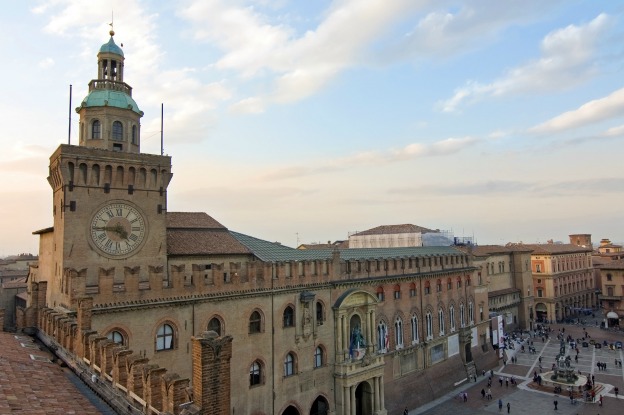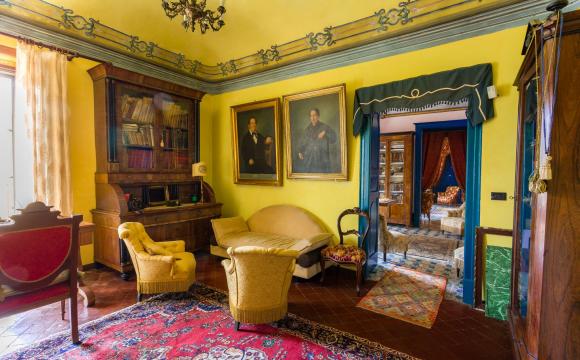La dotta, la grassa, la rossa (the learned one, the fat one, the red one).
This is how Bologna, the capital of Emilia-Romagna in north-central Italy, has been nicknamed, due to its delicious cuisine, the oldest university in the Western world, and its left-leaning politics (as well as its red roofs).
While often overlooked in favor of its most famous “neighbors” – Florence, Venice and Milan, between 40 minutes and one hour and a half away – Bologna, which boasts one of the best preserved historic centers in Europe, has plenty to offer the curious visitor - and you don’t have to share the sites with swarms of tourists!
As a native Bolognese, let me give you some suggestions on what not to miss when you visit.
Your exploration of Bologna should begin from Piazza Maggiore, the main square and the heart of town. Piazza Maggiore, one of Italy’s oldest and biggest squares, has been the center of Bologna’s political and social life since the 13th century. Here, citizens gathered to listen to the enunciation of new laws and to witness capital executions.
Several historic buildings and monuments surround the square:
-Palazzo D’Accursio, featuring the statue of Pope Gregory XIII, blessing passers-by, above the entrance. The Gregorian calendar, the international calendar in use today, takes its name from this pope, a Bologna native, who introduced it in 1582.
-Palazzo del Podestà, the first seat of local government; death sentences were carried out under the huge vault that connects Palazzo del Podestà and Palazzo Re Enzo (see below); you can still see two gallows where the condemned were hung.

-Palazzo Re Enzo, which takes its name from its most illustrious prisoner, Enzo, King of Sardinia and son of Emperor Federico II di Svevia, who was imprisoned there for 23 years.
-Statue of the Neptune, a masterpiece by Giambologna, sculpted between 1563 and 1566, and deemed scandalous at the time for its nudities. Today, it is a popular meeting point for the Bolognesi, who will say to their friends, “Ci vediamo al Nettuno”, let’s meet at the Neptune.
-Basilica of San Petronio, the Bolognesi’s most beloved church, dedicated to the patron saint of the city, Saint Petronius, who was bishop of Bologna in the 5th century. Its construction began in 1390; in 1514, when construction was still under way, a revised plan was proposed, with the intent to make it bigger than St. Peter’s Basilica in Rome; Pope Pius IV however cut the funds, and the church remains unfinished. This is evident when you look at the façade: pink and white marble makes up the bottom part, while the upper part is just brown stone.

On the left side of San Petronio is the Archiginnasio (Piazza Galvani 1), the first seat of the University of Bologna, built in 1563. Its jewel is the Teatro Anatomico (Anatomical Theater), where dissections of human cadavers performed by candlelight took place for the study of anatomy. The room, completely carved from spruce, is decorated with the statues of important physicians from the ancient world, like Hyppocrates and Galenus. Above the teacher’s desk are the two famous sculptures by Ettore Lelli of “gli spellati”, anatomical models displaying the muscles beneath the skin.
Tip: Sit at one of the cafés overlooking Piazza Maggiore for a glimpse into Bologna’s daily life while enjoying a cappuccino and brioche.
Now that you’ve refueled yourself with an Italian-style breakfast, take a break from sightseeing and go shopping! When I’m looking for quality brands at bargain prices, I head to “Castel Guelfo The Style Outlets”, 20 minutes from the city center [hop on a train at the central train station and get off at Castel San Pietro Terme, where you can board the free shuttle to the outlets].
Here, you’ll find an entirely pedestrianized, open-air mall, where you can shop for major Italian and international brands - think Borbonese, Trussardi, Pollini, Baldinini, Timberland, Stefanel, and many more - with discounts ranging from 30% to 70% off regular prices (at special times of the year, like the end of the season, discounts are even greater, up to 70% off the outlet prices).

If you’re like me, browsing around the 110 stores, offering designer’s fashion, sportswear, shoes, housewares, and cosmetics, will make you hungry; stop by one of the outlet’s cafés or restaurants for a nice Italian lunch, a pizza or a gelato. If you need a break from shopping, you can also relax by one of the green areas, or even chance upon an art exhibition or try some fun activities for the whole family.
Also, make sure you stop by the tourist information office within the outlets for helpful tips on what to see nearby (there’s plenty!): perhaps the charming borgo of Dozza for some wine tasting at the Enoteca Regionale Emilia-Romagna, Ravenna, the capital of mosaics, with eight UNESCO World Heritage sites, or, in the summer, the beaches of the famous Riviera Romagnola on the Adriatic Coast, an hour away (every Thursday during the summer season, a free return shuttle departs the Riviera – main stops Riccione and Rimini - for the outlets). Don’t forget to inquire about hotels in the area offering discounts to outlet customers – some even offer a “Tourist Card” for an additional 10% off the outlet stores prices.
As you head back to Bologna, I recommend checking out a site not many visitors get to see: the Sanctuary of Santa Maria della Vita (via Clavature 10), the most important example of Baroque art in Bologna. Inside the church is the “Compianto sul Cristo Morto” (Lamentation over Dead Christ) by Niccolò dell’Arca (1465), a powerful sculptural ensemble composed of six terracotta figures surrounding the lying Christ. It is the largest collection of terracotta sculptures of the Italian Renaissance.

A visit to Bologna would not be complete without climbing up the Torre Asinelli. The tower, built at the end of the 11th century, is the symbol of Bologna along with the leaning Garisenda, standing next to it. It’s 498 steep and narrow steps to the top, but the view over the red roofs of Bologna and the surrounding green hills is worth it.
Once you’re done with the tower, head nearby to Piazza Santo Stefano, possibly Bologna’s most charming square. Visit the Basilica of Santo Stefano, which locally we call “Sette Chiese” (Seven Churches); of the seven original churches, only four remain today, plus a courtyard, a cloister and a museum. Built on the location of an ancient pagan temple, the complex was originally meant to reproduce the Holy Sepulchre of Jerusalem. It is an incredibly fascinating (and peaceful) place, displaying a mix of different architectural elements.
Tip: time for a little rest - enjoy an aperitivo at one of the bars by the piazza, or around the Quadrilatero area, which is only a few steps away and your last stop on this one-day itinerary.

The Quadrilatero is the old medieval market and food shopping area, framed within a quadrilateral area (hence its name) by Piazza Maggiore, via Rizzoli, via Castiglione and via Farini. The market has occupied the same area in the city center since Roman times; it was especially important during the Middle Ages, when it was home to the headquarters of many corporations of merchants, which had begun to acquire great power with the shift to a new monetary economy.
The little streets within the Quadrilatero take their names from the shops and corporations that used to be based here: via Pescherie is where the fishmongers concentrated, via Orefici housed the goldsmiths, via Caprarie was home to the butchers selling sheep and goat meat, via Drapperie was for the upholsterers, and so on.

Historic shops where you can taste and buy Bologna’s signature dishes abound: tortellini, tagliatelle, lasagne and tortelloni; mortadella, Parmigiano Reggiano, the signature Bolognese sauce ragù, and local wines like Pignoletto. Try Atti (Via Caprarie 7) for pasta and bread, Salumeria Simoni (Via Drapperie 5/2a) for cold cuts and cheese, Tamburini (via Caprarie 1) for a little bit of everything. You could finish off the day at Tamburini’s wine bar for a cheese & cold cuts platter with crescenta (typical Bologna bread) and a glass of the local Pignoletto.
There you have it: your perfect Bologna escape!







